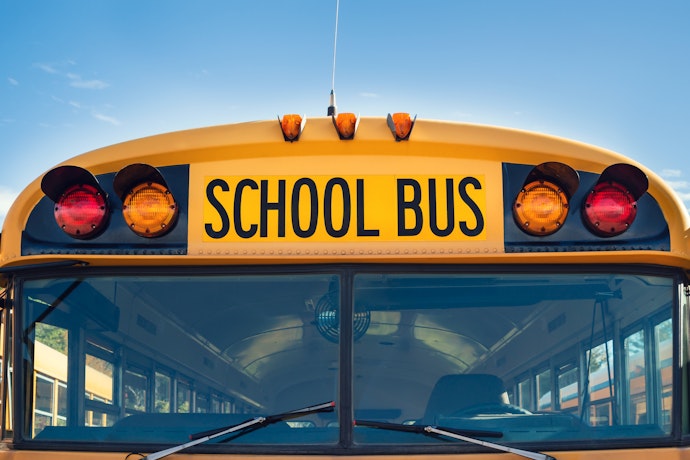Fleet Management Solutions for Every Department on Campus
Asset management software for schools, colleges and university fleets. Read how each higher education department can benefit...
Read more
The third full week of October marks National School Bus Safety Week—an essential public education program sponsored by the National Association for Pupil Transportation (NAPT).
During National School Bus Safety Week, parents, students, teachers and all individuals involved in schools and their fleets gain a better understanding of bus safety and beyond.
Did you know that the school bus is one of the safest vehicles on the road? Less than 1% of all traffic fatalities involve children on school transportation vehicles.1 Nevertheless, between 2010 and 2019, 240 school-age children lost their lives in school transportation-related accidents.2 Although the statistical risk remains low, the significance of school bus safety and the responsibility to protect all school children cannot be underestimated.
Let's delve into crucial school bus safety issues and how technology can support your school bus fleet’s safety efforts.
School buses are designed to be among the safer vehicles on the road, incorporating features such as rollover protection and high, protective seating to address occupants' safety. The National Highway Traffic Safety Administration (NHTSA) consistently explores innovative measures to enhance school bus safety.
While regulations are critical for supporting children's safety during their commute to school, it is noteworthy that of the 240 school children who lost their lives in accidents between 2010 and 2019, only 52 were occupants of the school transportation vehicle. The remaining 198 were either in another vehicle, walking or biking.2
Given that the children most vulnerable to school bus accidents are those close to the bus, rather than inside it, prioritizing bus driver behavior and habits becomes paramount. Leveraging integrated vehicle dashcams and GPS tracking technology to collect driving data enables personalized safety coaching for each driver. By utilizing visual evidence of any harsh driving incidents, managers can identify patterns and provide coaching on appropriate driver behavior, before it causes an accident.
Many contracted student bus services and school districts, like other fleets, encounter challenges when it comes to recruiting qualified drivers. Therefore, it becomes crucial to retain the existing drivers by promoting safe driver programs. The following measures can bolster driving skills and safety awareness:
Coaching school bus fleet drivers and providing proper training helps education fleets prioritize the highest level of safety for their students. As the individuals entrusted with transporting precious cargo, these drivers play a pivotal role in addressing the well-being of students.
Through effective coaching, drivers can enhance their skills, sharpen their decision-making abilities and develop a deep understanding of safety protocols. Comprehensive training equips them with the knowledge and expertise to navigate various challenges on the road, such as adverse weather conditions and unexpected situations. By prioritizing driver coaching and training, school bus fleets can instill a culture of safety, fostering a proactive approach that combats risks, helps mitigate accidents and promotes the secure transportation of students to and from school.
For parents, the assurance of knowing their children's whereabouts is an absolute necessity. Fortunately, advancements in innovative technology have made it possible for their child's school bus to offer them that invaluable peace of mind. By harnessing the power of cutting-edge technology, parents can now stay informed about their children's near-real time location during their bus commute, providing an additional layer of security and reassurance.
For instance, Edulog, a mobile app, provides parents with planned time and location information for their child's bus ride to school. By integrating data from Verizon Connect Reveal, Edulog helps fleets monitor school buses to keep students safe. This free integration can help your fleet:
From drivers diligently maintaining their vehicles to students actively participating in safe behaviors on and off the bus, every individual bears a profound responsibility in fostering a robust safety culture.
Investing in the right technology, establishing a robust safety culture and training programs can simplify the process of attracting new school bus operators while ensuring the safety of all motorists. Additionally, basing bonuses and rewards on a driver's personal safety record, supported by data and video evidence, can aid in developing, retaining and attracting the best drivers.
National School Bus Safety Week serves as a reminder to reassess and prioritize school bus safety. By addressing key issues such as driver coaching, leveraging vehicle location technology, driver safety training and optimizing school routes, we can significantly enhance the safety of our school children during their daily commute. Remember, our commitment to safety must extend beyond a single week and remain a steadfast priority throughout the year.
Want to see how Verizon Connect technology can support your school bus drivers? Get a free demo today.
1https://www.nhtsa.gov/road-safety/school-bus-safety
2NHTSA. (2021). School-Transportation-Related Crashes. Washington, DC; National Highway Traffic Safety Administration. https://crashstats.nhtsa.dot.gov/Api/Public/Publication/813105
Tags: Community, Dispatching & Scheduling, Fleet utilization, Fuel cost management, Inspections, Performance & Coaching, Routing, Safety, Service level compliance, Team Management, Vehicle Maintenance




Find out how our platform gives you the visibility you need to get more done.
Asset management software for schools, colleges and university fleets. Read how each higher education department can benefit...
Read moreTelematics is helping change how school bus fleets are managed, and benefits can include improved passenger safety, streamlined...
Read moreLearn how fleet management and video telematics can improve driver safety, reduce accidents, and optimize operations.
Read moreLearn how innovations in video powered by AI and machine learning are helping to reshape safety and efficiency.
Read more